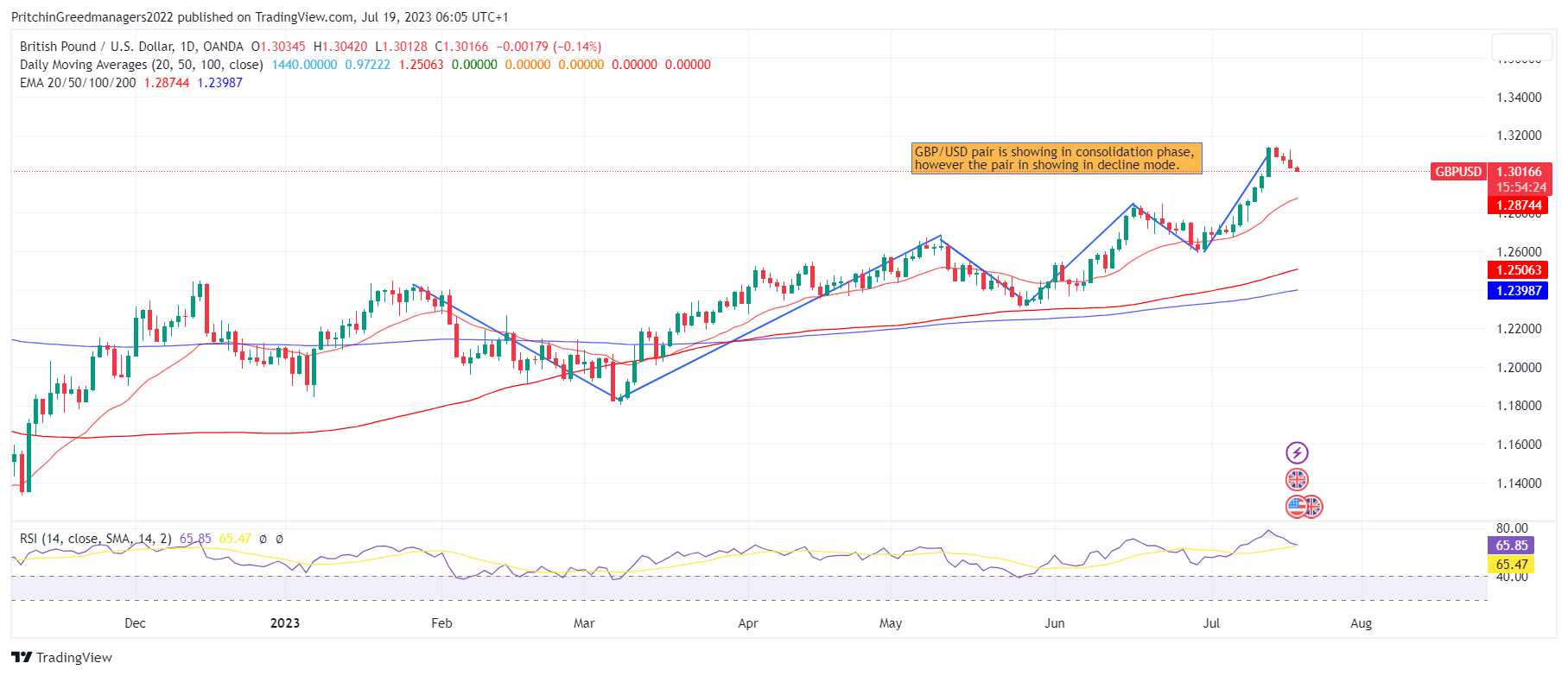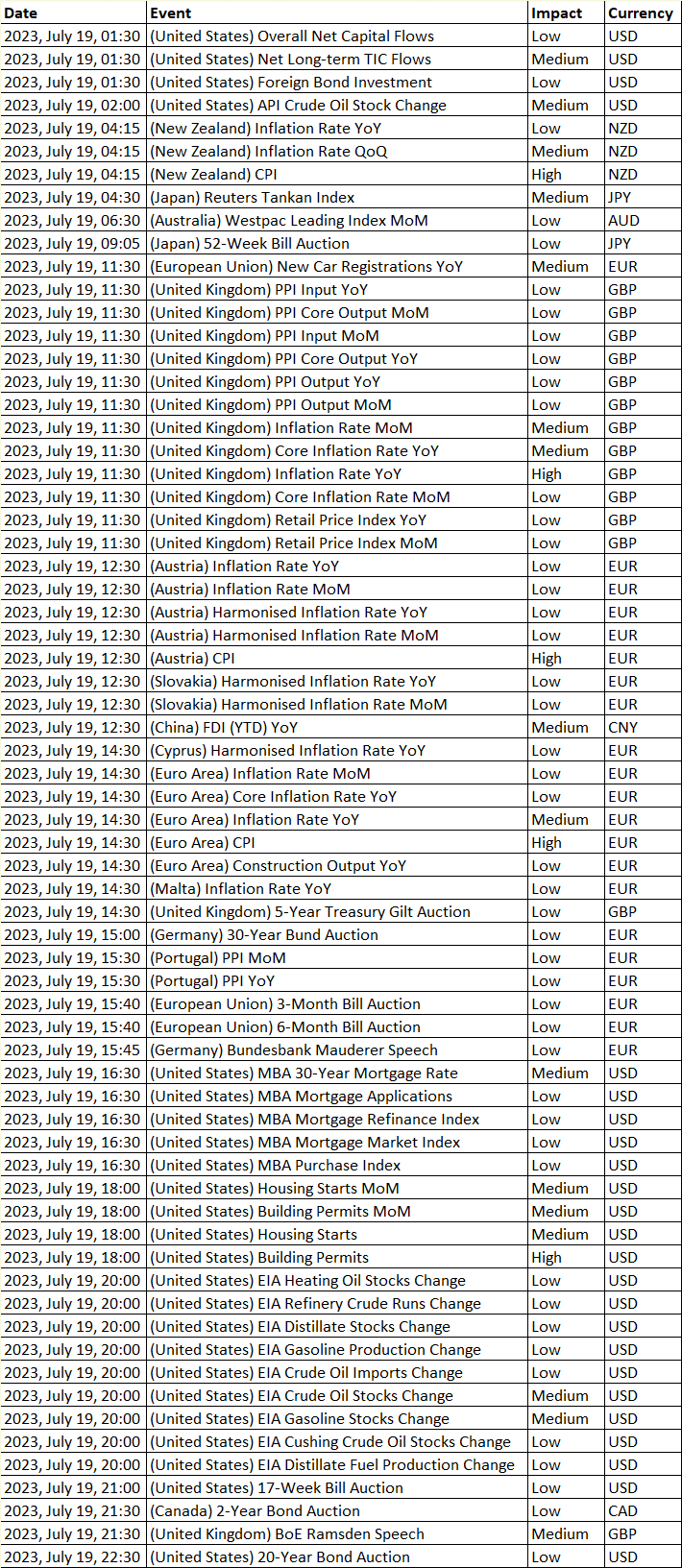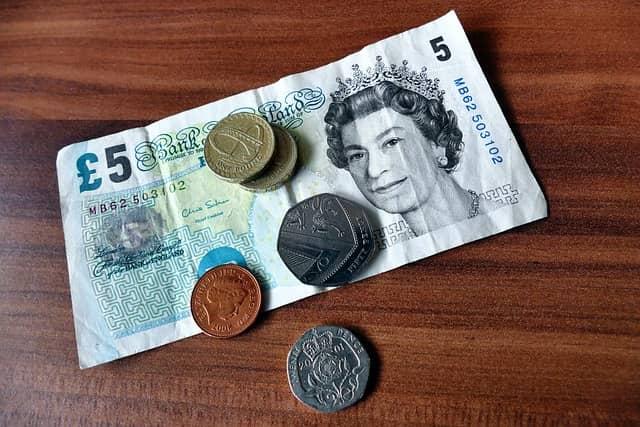GBP/USD Analysis: Cable Faces Resistance at 1.3000- 19-07-2023
GBP/USD Analysis
Key Points: -
- The GBP/USD pair continues its downward drift for the fourth consecutive day, facing pressure from a slight strengthening of the US Dollar.
- Anticipated less hawkishness from the Federal Reserve and the prevailing risk-on sentiment are expected to constrain gains for the safe-haven US Dollar.
- Increasing expectations of more aggressive interest rate hikes by the Bank of England (BoE) should help limit losses ahead of the release of UK Consumer Price Index (CPI) data.
Today's Scenario: -
The GBP/USD pair continues to face selling pressure for the fourth consecutive day on Wednesday, moving further away from its peak reached in April 2022, around the 1.3140 level last week. During the Asian session, spot prices declined, reaching a four-day low. However, the bulls managed to defend the psychological level of 1.3000, at least for now.
The US Dollar (USD) is gaining some positive momentum and aims to build on the rebound from a 15-month low witnessed overnight. This upward pressure on the USD is putting downward pressure on the GBP/USD pair. Data released on Tuesday revealed that core US Retail Sales, which exclude automobiles, gasoline, building materials, and food services, remained resilient in June. This raises doubts about whether the Federal Reserve (Fed) will adopt a more dovish policy stance. The prospect of a less accommodative Fed is seen as a supportive factor for the Greenback.
Despite this, the markets have been pricing out the possibility of further interest rate hikes by the Fed after the anticipated 25 basis points increase at the upcoming policy meeting on July 25-26. This view is reinforced by the ongoing decline in US Treasury bond yields. Additionally, the prevailing bullish sentiment in equity markets is expected to limit the strength of the safe-haven US Dollar. On the other hand, the GBP/USD pair may receive support from rising expectations of a more aggressive tightening by the Bank of England (BoE).
In fact, interest-rate swaps indicate that the BoE might raise interest rates from the current 5% to a peak of 6.5% in the current cycle, the highest level since 1998. The aim of such a move would be to reduce demand and bring down inflation. These expectations were fueled by stronger wage growth data in the UK, which according to BoE Governor Andrew Bailey and UK Finance Minister Jeremy Hunt, is hindering efforts to curb inflation. Bailey also mentioned last week that inflation is still significantly high, although he expects it to decrease sharply this year.
Therefore, the focus of the market will remain on the latest UK Consumer Price Index (CPI) report, scheduled for release later on Wednesday. This report will play a crucial role in shaping the BoE's near-term policy outlook and provide fresh momentum for the British Pound. Additionally, during the early North American session, traders will be paying attention to US housing market data, specifically Building Permits and Housing Starts. Nevertheless, considering the aforementioned fundamental factors, there is a likelihood of dip-buying emerging around the GBP/USD pair.
Diagram of GBP/USD: -

Economic Events: -

Buy Scenario: -
On the upside, a recovery in GBP/USD, confirmation is required from the support-turned-resistance line near 1.3085 to persuade buyers of a potential upward move.
However, the weekly resistance line around 1.3125, along with various levels established in late 2021 and early 2022 around 1.3175-80, are likely to impede any further upside momentum for the Pound Sterling. Till we do not advise to buy GBP/USD.
Sell Scenario: -
During the early hours of Wednesday's Asian session, the GBP/USD pair exhibits a back-and-forth movement around 1.3030, reflecting the anxiety among traders ahead of the upcoming data release. The pair has been on a downward trend for the past three days after reaching a 15-month high last week, causing uncertainty among both bullish and bearish participants.
The recent breakdown below a support line that had been in place for two weeks, now acting as immediate resistance at 1.3085, along with bearish signals from the Moving Average Convergence Divergence (MACD) indicator, is tempting GBP/USD sellers.
Nevertheless, there is a formidable support zone in the range of 1.3000-2985, comprising a resistance-turned-support line that has been intact for ten weeks and the 50-day Simple Moving Average (SMA). This area poses a significant challenge for the bears attempting to push the Cable lower.
If the GBP/USD bears manage to breach the 1.2985 support level, especially in the event of a downbeat UK Consumer Price Index (CPI) report for June, the possibility of a decline towards the previous monthly high around 1.2850 cannot be disregarded. Till then we do not advise selling GBP/USD.
Support and Resistance Level: -
Support Resistance
S1 1.3001 - R1 1.3099
S2 1.2966 - R2 1.3161
S3 1.2903 - R3 1.3196






Discussion